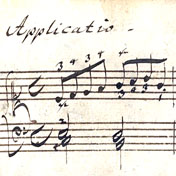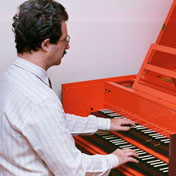Excerpts from this book:
First Clavier-Büchlein vor Anna Magdalena Bach (dated 1722), French Suite I, Gigue,
last systems in the 1st and 2nd page. The blue arrows show the significant alignments.
EDITORIAL PROCESS FOR THE MUSICAL SCORE
Readers of our “J.S. Bach Partitas with Baroque fingering” edition will wonder why our editorial process is here completely different. This is because we have here a totally different set of sources.
In the Partitas two sources sanctioned by the composer are extant: his first editions of the single Partitas, and the final edition of the Six Partitas together...
In the French Suites the situation is one order of magnitude more complex. No edition was ever published during the lifetime of the composer. The earliest extant version is fragmentary and consists of Bach's autograph pages entered in the first “Clavier-Büchlein vor Anna Magdalena Bach”, dated 1722, ... and ... in the second Clavier-Büchlein, c.1725 .
Together with other mostly-complete sources we have a total of 19 (!) eighteenth century manuscripts, most of them originating from the composer’s milieu: these show different readings, sometimes quite significant. Modern research has been able to classify most of these sources into “early” and “final” versions, although a few important manuscripts ... appear to be an admixture or intermediate version, and it is apparent that the pieces underwent many processes of amendments over the course of a few years. Not surprisingly, collating the sources we find that variants are legion, mostly in ornaments but also in quite a few note pitches: there are also a few large-scale discrepancies.
Our edition here is based on the following secondary sources:
- Bach-Gesellschaft revised Naumann Edition ... a very acceptable reading of the sources.
- Henle’s Schiedeler edition ... the critical apparatus discusses different readings.
- The corrections pencilled into a copy of the latter by the present author.
Why introduce corrections into the scholarly work by Schiedeler? Because ... given the many differences between the extant sources, the present author ... has found good reasons to prefer a different choice in a few passages. ...
FINGERING AND BACH
The goal of performing on historical instruments is to try to play an early music score with the overall sound, articulation, ornamentation and other subtleties the composer had in mind. To achieve this, we have to play a “period instrument” with a “period technique” ...
It is unfortunate that—except for a few modern harpsichord methods with selected pieces from different composers—until very recently (when the author's edition of François Couperin's Pièces de Clavecin, Fingered with Baroque Technique, Vol. I was published in April 2015) no modern edition of Baroque keyboard music included Baroque fingerings. This does not make matters easy for early-keyboard players who wish to perform J.S. Bach and other Baroque composers with a period technique. ...
Hopefully, the author's Baroque fingering method—based on collating the historical sources—and now the present fully-Baroque-fingered edition of the keyboard French Suites, will help both students and professional harpsichordists to achieve the stylish rendering that these keyboard masterpieces deserve.
FINGERING CONVENTIONS
... Our approach is practical and also economical: a finger number is added to the score whenever (and only if) it changes the obvious diatonic sequence ... This diatonic convention applies to scales, counterpoint, ornaments and also arpeggios ...
It is also unnecessary to notate fingers 1 and 5 when obvious, especially when the same hand plays notes spaced a fifth or more apart. For example, when playing with the right hand, if a note has been played with 3 (middle finger) and the following note is a fourth up, it is automatically meant to be played by 5 unless otherwise notated. ...We will call this the extreme position convention.
Thanks to these conventions, our score actually suggests a finger for every single note in the French Suites, yet using as little finger numbers as possible.
COMMENTS ON THE PERFORMANCE AND ERRORS
...
SUITE III IN B MINOR BWV 814
...
Gigue (Giga)
STYLE. The 3/8 metre and first few bars may suggest the French dance but—as also shown in Kayser's title “Giga”— soon the piece develops into an Italianate fast counterpoint in two voices, belonging to the “Giga IIb” subtype (see ... Playing the Baroque Harpsichord, Section 5.5, subsection “Giga”, p. 132) due to the prevailing diminutions in semiquavers. The articulation is detached. ...
ORNAMENTS. ... except for a few original ones found in the first section, they are all found only in Gerber's and Kayser's copies: therefore they are unlikely to have originated with the composer, and have been omitted from the present edition.
Kayser MS (c.1720-30), French Suite III, Giga, first section.
...
SUITE VI IN E MAJOR BWV 817
...
Polonaise
STYLE. The Polonaise was a Polish dance already known in other European countries since the 17th century. The metre is 3/4, and the typical Polonaise rhythm has the bar consisting of six quavers, with some subtler rhythms in semiquavers. This is the only Polonaise J.S. Bach ever composed for the keyboard, and consists of three groups of 8 bars each. The quavers are égales due to the diminutions in semiquavers. Faster than a Sarabande, it is slower than a Minuet. ...
ARTICULATION. The specific slurs in system 1 bar 3 and system 3 bar 1, with a similar repeated-note motif, are evidence of the prevailing non-legato articulation of most quavers and of the groups of two semiquavers, whereas the many groups of four semiquavers within a crotchet are to be performed legato.
FINGERING. The above-mentioned slurs provide a good occasion to apply the "repeated finger"
principle sanctioned by Baroque sources: repeating a note with the same finger supports a
detached articulation. ...
REGISTRATION. We are back to the 8'+8' we used for the Sarabande.
...



